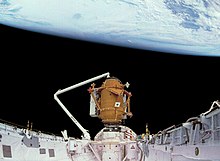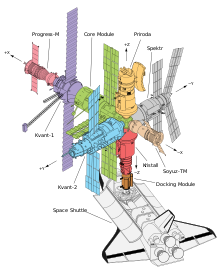STS-74
Installation of the three Space Shuttle Main Engines (SSMEs) on Atlantis was completed on 5 September 1995, as were closeout operations on the Russian docking module.
The initial launch attempt, scheduled for 11 November 1995 at 7:56 am EST (12:56 UTC) was postponed due to poor weather at the Transatlantic Abort (TAL) site.
Approximately three hours into the flight, Commander Ken Cameron and Pilot Jim Halsell fired the orbiter's reaction control thrusters in the first of a series of rendezvous burns that refined Atlantis's path towards Mir.
Mission specialists Jerry Ross and Bill McArthur inspected the spacesuits they would don should a spacewalk become necessary during the mating or docking operations.
The camera later assisted Commander Ken Cameron in final piloting tasks as Atlantis moved towards and docked with Mir.
Cameron, Hadfield and other available crew members also spent the morning answering questions posed by Canadian reporters located in Montreal and Toronto.
With all of the systems that were to put the Russian Docking Module in place for a flight day 4 link-up with Mir checked out and ready to go, the STS-74 crew settled down for 8 hours of sleep that afternoon.
Shortly after the capture, Commander Ken Cameron expressed the crew's appreciation for the training that prepared them for the docking module installation.
The camera later provided the primary visual cue for Cameron as he maneuvered Atlantis to its docking with Mir on flight day four.
[2] During the three days of combined Shuttle-Mir operations, Atlantis's crew transferred various items from the shuttle to the space station, including water, supplies, and equipment, along with two new solar arrays (one Russian and one jointly-developed) to upgrade Mir.
Three PASDE canisters, located throughout the cargo bay, also photogrammetrically recorded structural response data of the Mir solar arrays during the docked phase of the mission.
This data was later analyzed on the ground to verify the use of photogrammetric techniques to characterize the structural dynamics of the array, thus demonstrating that this technology would result in cost and risk reduction for the International Space Station.
The main landing gear touched down at 12:01:27 pm EST (17:01:27 UTC) on 20 November, a mission elapsed time (MET) of 8 days 4 hours 30 minutes and 44 seconds.



